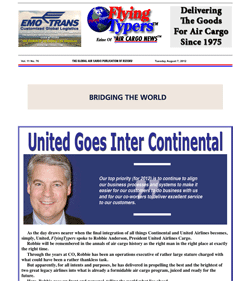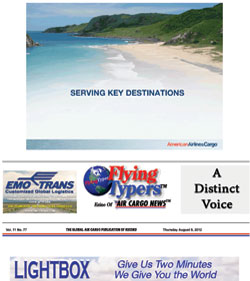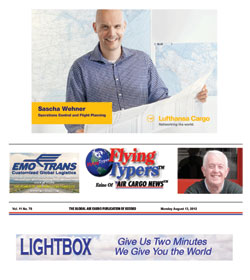| 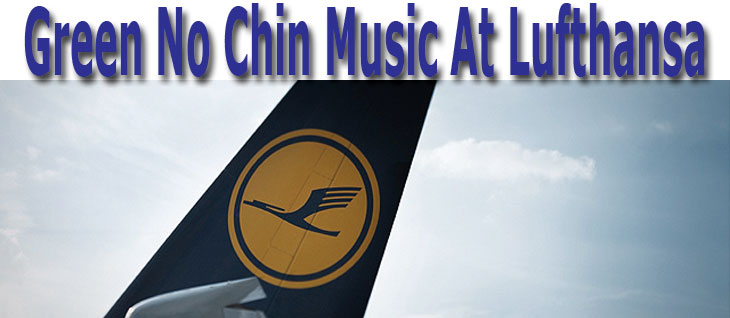
“We
know we are in a dirty and
loud business,” said
Tim Holderer, Senior First
Officer, MD-11, Lufthansa
Cargo AG.
“But
at Lufthansa we are all committed
and striving for a sustainable
way of flying. We want to
conduct our business as clean
as we can and with as little
negative environmental impact
as possible.”
Having
just spent all of Monday in
session after session of all
things environmental at Lufthansa
Cargo Frankfurt, that statement
from a young, bright, first
officer—who is out there
flying an MD-11 freighter
to destinations all over the
world—sticks in the
mind.
No
doubt every time Senior First
Officer Tim takes off and
lands in places like Quito,
Ecuador, where he likes to
spend his layovers riding
a bike up and down roads alongside
local volcanoes whilst marveling
at the beauty of lush green
earth and amazing vistas,
he is thinking about what
can be done to fly and live
cleaner to preserve the earth.
When
you think about it, although
some might like to argue the
point, the air cargo business
and, for that matter, transportation
in general make more chin
music (talk) about climate
care and environmental issues
than they do anything else.
Sure,
everybody has a program—some
more aggressive and result
driven than others—but
in 2012 a soft business climate
has put survival on the front
burner as a regular headline
item.
Much
to its credit, Lufthansa Cargo
moved climate care to global
attention on Monday, August
13, with their annual Climate
Care Conference held in Frankfurt,
Germany.
In
Germany, where environmental
issues are essentially on
the radar all the time, Lufthansa
Cargo stood up and was counted
not only as a participant,
but in many ways a leader
in the movement toward sustainable
environmental business practices.
Presentations
were wide ranging and all
encompassing, and included
everything from the development
of lightweight containers,
to biofuels, to how aircraft
can be flown to lessen their
noise.
Other
initiatives were discussed,
including the Lufthansa plan
to receive a fleet of up to
ten new B777Fs (five firm,
five options beginning in
2013) and a new $600 million
cargo center in Frankfurt,
which will be approved possibly
as early as September of this
year and will offer significant
advantages as the carrier
further targets environmental
issues.
While
much of this news had been
revealed previously, it did
not lessen the impact of the
sum effort of going green
at the carrier.
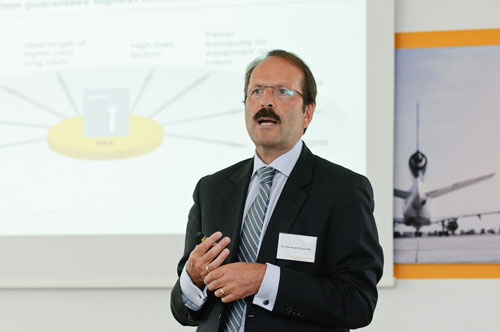 While
not alone amongst airlines
that are bringing these issues
forward, Lufthansa Cargo is
certainly out front and pulling
away in the effort to bring
greater awareness of the importance
of the environment to both
the air cargo industry and
the rest of the world as well.
While
not alone amongst airlines
that are bringing these issues
forward, Lufthansa Cargo is
certainly out front and pulling
away in the effort to bring
greater awareness of the importance
of the environment to both
the air cargo industry and
the rest of the world as well.
Dr. Karl-Rudolf Rupprecht,
Executive Board Member, underscored
by his presence the import
of the conference to the carrier
by delivering both an overview
and keynote address, offering
attendees a glimpse of the
true state of the Lufthansa
Cargo “green vision.”
“Hard
work and tough project management
are a huge investment, but
well worth it,” Dr.
Rupprecht said.
“Today,
Frankfurt is the seventh largest
hub in the world and of course
we operate our hub and spoke
system here.
“All
of our decisions are pointing
toward environmental efficiency.
“At
Lufthansa, the environment
is not just talk, but reality.
“We
have made a commitment to
reduce the carbon footprint.
“But
what must be done to both
reduce the carbon footprint
and still grow as a business?
“Our
long term plan is to reduce
our carbon footprint 25 percent
by 2020.
“How
do we achieve this?
“Our
baseline for the aviation
industry is a four pillar
strategy: technological progress,
operational measures, improved
infrastructure and economic
measures.
“All
of this has to be done without
compromising flight safety.
“At
Lufthansa, we are proactive
and have employees involved
in achieving environmental
sustainability at all levels.
“We
implement more than 50 fuel
saving measures in flight
operation.
“Every
measure counts.
“For
example, 40 kilos of operation
manuals were replaced by an
electronic flight bag.
“That
small reduction of 20 kg weight
can generate fuel savings
of 100 tons per year, a reduction
in CO2 emissions of 3,151
tons—equal to two flights
from FRA to Sharjah.”
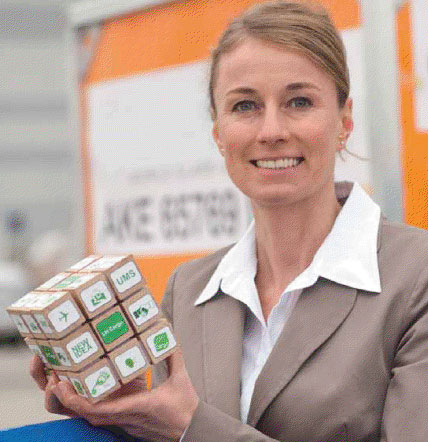 Bettina
Jansen, Head of Environmental
Management at Lufthansa Cargo,
echoes Herr Rupprecht's forthright
statements. “Our commitment
is leading the way in environmental
issues. Bettina
Jansen, Head of Environmental
Management at Lufthansa Cargo,
echoes Herr Rupprecht's forthright
statements. “Our commitment
is leading the way in environmental
issues.
“We
began this initiative in 2007
and put in a specific policy
in the fall of 2009. The Lufthansa
Cargo Environmental cube encompasses
eight points for customers
as well as partners and serves
as our roadmap toward reaching
our goal of achieving that
targeted 25 percent reduction
in CO2 emissions by 2020.
“Cube
essentials include our internal
activities—in the air,
on the ground, everywhere—and
also includes our Environmental
Management System and dialogue
with scientists and customers
and partners with communications
to everyone both inside and
outside of Lufthansa Cargo.
“We
are working to optimize our
flight routes and approach
procedures. Made of composite
materials, our lightweight
containers are lighter and
stronger and also reduce CO2
impact significantly.
“Most
importantly, we know that
our efforts work, leading
us to believe that we will
achieve our goals.
“Lufthansa
Cargo succeeded in reducing
CO2 emissions form 781 to
496 grams per ton-kilometer
transported between 1996 and
2001,” Bettina Jansen
said.
Geoffrey/Flossie
|




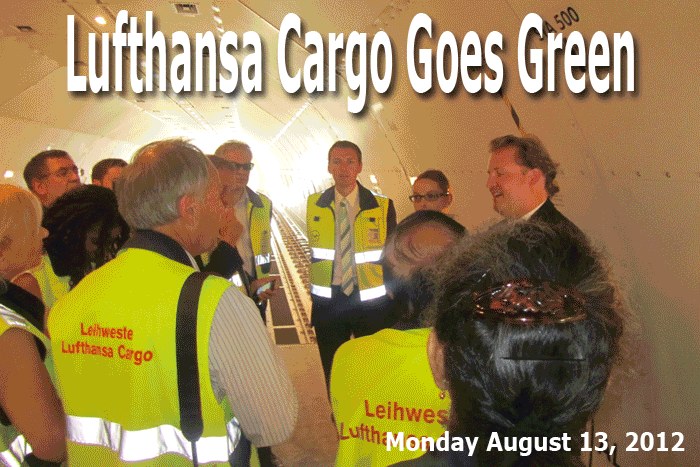

 While
not alone amongst airlines
that are bringing these issues
forward, Lufthansa Cargo is
certainly out front and pulling
away in the effort to bring
greater awareness of the importance
of the environment to both
the air cargo industry and
the rest of the world as well.
While
not alone amongst airlines
that are bringing these issues
forward, Lufthansa Cargo is
certainly out front and pulling
away in the effort to bring
greater awareness of the importance
of the environment to both
the air cargo industry and
the rest of the world as well. Bettina
Jansen, Head of Environmental
Management at Lufthansa Cargo,
echoes Herr Rupprecht's forthright
statements. “Our commitment
is leading the way in environmental
issues.
Bettina
Jansen, Head of Environmental
Management at Lufthansa Cargo,
echoes Herr Rupprecht's forthright
statements. “Our commitment
is leading the way in environmental
issues. 
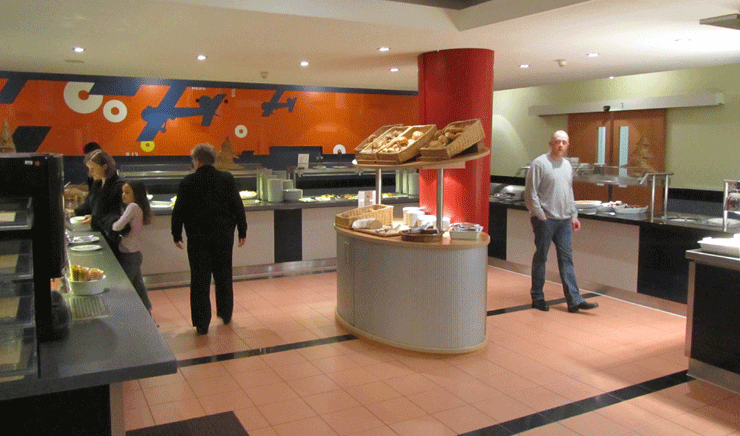
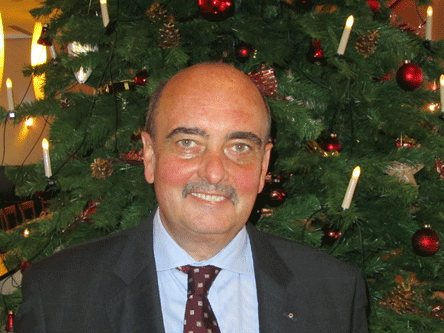 The
best airport breakfast is
at Frankfurt International
Airport’s Intercity
Hotel in Cargo City Süd.
The
best airport breakfast is
at Frankfurt International
Airport’s Intercity
Hotel in Cargo City Süd.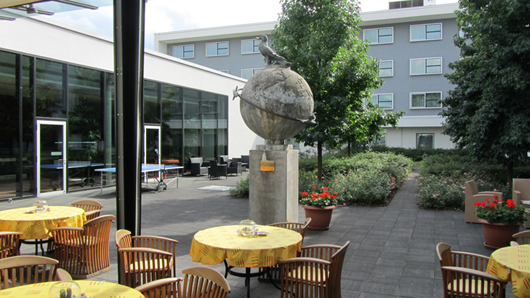 It
sits in the center of an outdoor
garden: a column with a stylized
globe of the world, bands
of aircraft encircling it,
atop which a bird of peace
holds in its beak a gilded
olive branch.
It
sits in the center of an outdoor
garden: a column with a stylized
globe of the world, bands
of aircraft encircling it,
atop which a bird of peace
holds in its beak a gilded
olive branch.